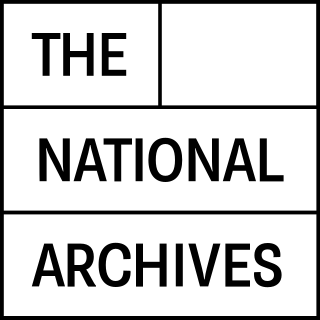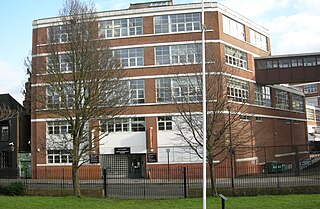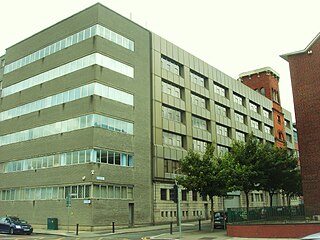
An archive is an accumulation of historical records or materials – in any medium – or the physical facility in which they are located.

Somerset House is a large building complex situated on the south side of the Strand in central London, overlooking the River Thames, just east of Waterloo Bridge. The Georgian era quadrangle was built on the site of a Tudor palace originally belonging to the Duke of Somerset in 1547. The present Somerset House was designed by Sir William Chambers, begun in 1776, and was further extended with Victorian era outer wings to the east and west in 1831 and 1856 respectively. The site of Somerset House stood directly on the River Thames until the Victoria Embankment was built in the late 1860s.

The National Archives is a non-ministerial department of the Government of the United Kingdom. Its parent department is the Department for Culture, Media and Sport of the United Kingdom of Great Britain and Northern Ireland. It is the official national archive of the UK Government and for England and Wales; and "guardian of some of the nation's most iconic documents, dating back more than 1,000 years." There are separate national archives for Scotland and Northern Ireland.

Lord of the manor is a title that, in Anglo-Saxon England and Norman England, referred to the landholder of a rural estate. The titles date to the English feudal system. The lord enjoyed manorial rights as well as seignory, the right to grant or draw benefit from the estate. The title is not a peerage or title of upper nobility but was a relationship to land and how it could be used and those living on the land (tenants) may be deployed, and the broad estate and its inhabitants administered. The title continues in modern England and Wales as a legally recognised form of property that can be held independently of its historical rights. It may belong entirely to one person or be a moiety shared with other people. The title is known as Breyr in Welsh.

Pilton is a village and civil parish in Somerset, England, situated on the A361 road in the Mendip district, 3 miles (5 km) south-west of Shepton Mallet and 6 miles (10 km) east of Glastonbury. The village has a population of 998. The parish includes the hamlets of West Compton, East Compton, Westholme, Beardly Batch and Cannards Grave.

The London Archives is the principal local government archive repository for the Greater London area, including the City of London. It is administered and financed by the City of London Corporation, and is the largest county record office in the United Kingdom.
The court leet was a historical court baron of England and Wales and Ireland that exercised the "view of frankpledge" and its attendant police jurisdiction, which was normally restricted to the hundred courts.
A Nonconformist register is broadly similar to a parish register, but deriving from a nonconformist church or chapel.
A vestry was a committee for the local secular and ecclesiastical government of a parish in England, Wales and some English colonies, which originally met in the vestry or sacristy of the parish church, and consequently became known colloquially as the "vestry". At their height, the vestries were the only form of local government in many places and spent nearly one-fifth of the budget of the British government. They were stripped of their secular functions in 1894 and were abolished in 1921.

The National Archives of Ireland is the official repository for the state records of Ireland. Established by the National Archives Act 1986, taking over the functions of the State Paper Office and the Public Record Office of Ireland. In 1991, the National Archives moved to its current premises in Bishop Street, Dublin. The Archives stand on the site of the Jacob's Factory, one of the garrisons held by rebels during the 1916 Easter Rising.

The Parliamentary Archives of the United Kingdom preserves and makes available to the public the records of the House of Lords and House of Commons back to 1497, as well as some 200 other collections of parliamentary interest. The present title was officially adopted in November 2006, as a change from the previous title, the House of Lords Record Office.
A parish constable, also known as a petty constable, was a law enforcement officer, usually unpaid and part-time, serving a parish. The position evolved from the ancient chief pledge of a tithing and takes its name from the office of constable with which it was originally unconnected.

The Royal Commission on Historical Manuscripts, was a United Kingdom Royal Commission established in 1869 to survey and report on privately owned and privately held archival records of general historical interest. Its brief was "to make inquiry as to the places in which such Manuscripts and Papers were deposited", and to report on their contents. It remained in existence until 2003, when it merged with the Public Record Office to form The National Archives. Although it technically survives as a legal entity, its work is now entirely subsumed into that of The National Archives.

Selworthy is a small village and civil parish 5 kilometres (3 mi) from Minehead in Somerset, England. It is located in the National Trust's Holnicote Estate on the northern fringes of Exmoor. The parish includes the hamlets of Bossington, Tivington, Lynch, Brandish Street and Allerford.

Public Record Office Victoria (PROV) is the government archives of the Australian State of Victoria. PROV was created by the Victorian Public Records Act 1973 with responsibility for the better preservation management and utilisation of the public records of the State. It is an agency of the Department of Government Services.
The Centre for Kentish Studies was a combined county record office and local studies library, based for many years at the County Hall, Maidstone, Kent, UK. The original archive repository, known as the Kent Archives Office, was first established by Kent County Council in 1933, placing it amongst the earliest local authority record offices in England. It merged with the county's local studies library in 1990 and the enlarged unit thereafter adopted the new name.
Originally within the United Kingdom the title of diocesan record office would frequently have referred to a church-owned diocesan registry or chancery. This would have been where the episcopal registers, administrative papers and title deeds were preserved under the general superintendence of the diocesan chancellor.

The British Records Association is a British learned society founded in 1932 to promote the preservation, understanding, accessibility and study of historic records and archives. It is a registered charity. It issues a journal, Archives, and other publications; hosts conferences and seminars; and undertakes other activities to promote the care and preservation of archives and the interests of archive users at a national level. Membership is open to all, and the association therefore plays a particular role as a forum which brings together owners of archives, academic and amateur documentary researchers, archivists and librarians, and institutions and societies concerned with archives.
The Lancashire Archives, previously known as the Lancashire Record Office, is a county record office located in the city of Preston which serves Lancashire, England. It was established in 1940.

The Somerset Archives and Local Studies holds the archives for the county of Somerset, England. The archives are held at Brunel Way, Langford Mead, Norton Fitzwarren, Taunton, and run by Somerset County Council.














